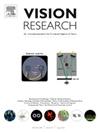Including the nonlinear response of neurons to improve the prediction of visual acuity across levels of contrast, luminance, and blur
IF 1.4
4区 心理学
Q4 NEUROSCIENCES
引用次数: 0
Abstract
We present a theoretical model that predicts visual acuity changes over extended ranges of stimulus contrast, luminance, and optical blur. We highlight the significance of neuronal response nonlinearity to optical contrast in achieving model agreement with experimental data. The model operates by computing, for each experimental condition, a parameter termed data separability within the framework of statistical decision theory. We assume a theoretical model observer that utilizes sharp image templates for optotype identification, consistent with our previous work for small ( D) optical aberrations (Leroux et al., 2024). The model incorporates the nonlinear response of visual neurons to contrast stimuli in the simulation of visual images. We digitalized measurements from Johnson and Casson (1995), who studied the combined effects of stimulus contrast (6 to 97%), luminance (0.075 to 75 cd/m), and blur (0 to 8 D positive lens), and compared our model’s predictions to their data. The model achieved an overall root-mean-square residual of 0.048 logMAR for measurements spanning 1.73 logMAR. Accounting for nonlinearity proved critical in predicting acuity across these extended ranges of experimental conditions. This approach may also be necessary for modeling acuity under non-standard experimental conditions and/or for subjects with pathologies.
包括神经元的非线性响应,以提高对对比度,亮度和模糊水平的视觉敏锐度的预测
我们提出了一个理论模型来预测视觉敏锐度在刺激对比度、亮度和光学模糊的扩展范围内的变化。我们强调了神经元响应非线性对光学对比度的重要性,以实现与实验数据的模型一致。该模型通过在统计决策理论框架内计算每个实验条件下称为数据可分性的参数来运行。我们假设有一个理论模型观测器,它利用锐利的图像模板进行光型识别,这与我们之前对小(<0.5 D)光学像差的研究一致(Leroux等人,2024)。该模型结合了视觉神经元对对比刺激的非线性响应来模拟视觉图像。我们将Johnson和Casson(1995)的测量数据数字化,他们研究了刺激对比度(6%至97%)、亮度(0.075至75 cd/m2)和模糊(0至8 D正透镜)的综合效应,并将我们的模型预测与他们的数据进行了比较。对于跨越1.73 logMAR的测量,该模型的总体均方根残差为0.048 logMAR。在这些扩展的实验条件范围内预测灵敏度时,非线性被证明是至关重要的。这种方法对于非标准实验条件下的敏锐度建模和/或有病理的受试者也是必要的。
本文章由计算机程序翻译,如有差异,请以英文原文为准。
求助全文
约1分钟内获得全文
求助全文
来源期刊

Vision Research
医学-神经科学
CiteScore
3.70
自引率
16.70%
发文量
111
审稿时长
66 days
期刊介绍:
Vision Research is a journal devoted to the functional aspects of human, vertebrate and invertebrate vision and publishes experimental and observational studies, reviews, and theoretical and computational analyses. Vision Research also publishes clinical studies relevant to normal visual function and basic research relevant to visual dysfunction or its clinical investigation. Functional aspects of vision is interpreted broadly, ranging from molecular and cellular function to perception and behavior. Detailed descriptions are encouraged but enough introductory background should be included for non-specialists. Theoretical and computational papers should give a sense of order to the facts or point to new verifiable observations. Papers dealing with questions in the history of vision science should stress the development of ideas in the field.
 求助内容:
求助内容: 应助结果提醒方式:
应助结果提醒方式:


